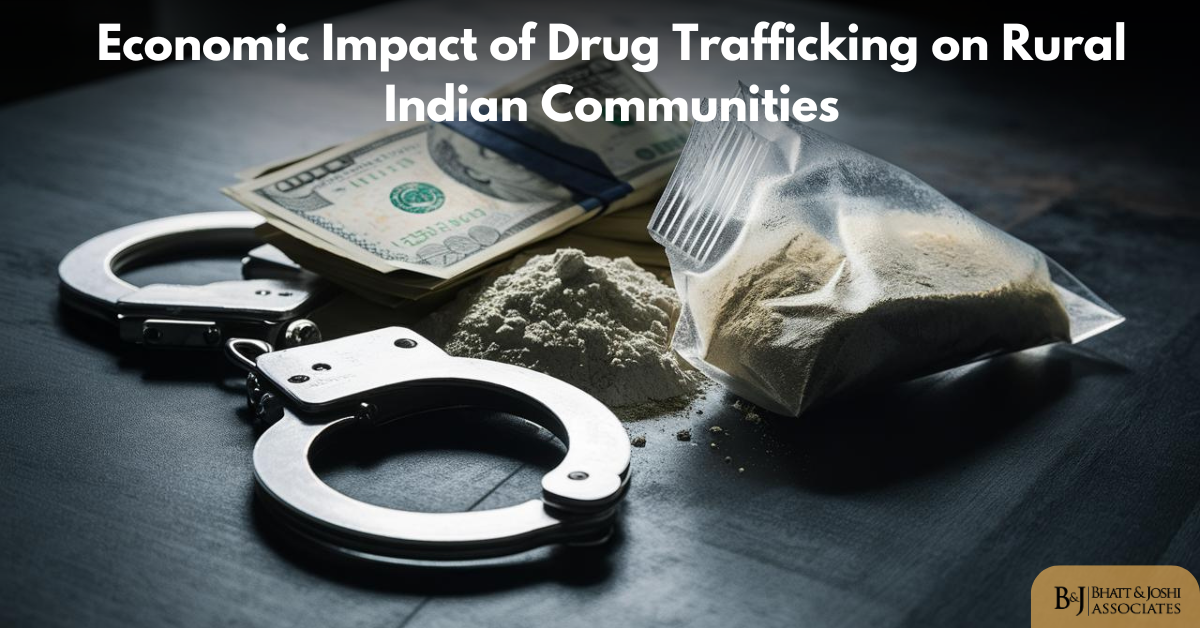Introduction
Drug trafficking, a global issue with far-reaching consequences, has significant economic repercussions for rural communities in India. These areas, often characterized by their socio-economic vulnerability and limited resources, are particularly susceptible to the adverse effects of the drug trade. This article delves into the Economic Impact of Drug Trafficking on Rural Indian Communities, exploring how it disrupts local economies, influences social structures, and impedes development efforts.
Socio-Economic Landscape of Rural India
To understand the economic impact of drug trafficking, it is crucial to first grasp the socio-economic challenges in rural areas of India. Rural regions are primarily agrarian, with agriculture being the main livelihood for many. These areas often face issues such as limited infrastructure, inadequate healthcare and education, and low economic diversification.
The economic stability of rural communities depends heavily on agriculture and small-scale industries. However, problems like poverty, unemployment, and underdevelopment make them particularly vulnerable. In this context, drug trafficking can have a disproportionately damaging effect, further straining their already fragile economies.
The Penetration of Drug Trafficking in Rural Areas
Drug trafficking has increasingly infiltrated rural areas in India, often starting in regions where economic opportunities are limited. Traffickers exploit these communities by establishing supply chains and distribution networks that capitalize on the lack of oversight and enforcement. Rural areas provide a conducive environment for drug cultivation and trade due to their remote locations and sparse law enforcement presence.
In regions like the northeastern states of India—Arunachal Pradesh, Manipur, and Mizoram—drug trafficking is particularly pervasive. The proximity to international borders makes these areas vulnerable to the smuggling of narcotics, including opiates and synthetic drugs. As traffickers move their operations into rural areas, they can bypass the stricter controls found in urban centers.
Economic Disruption Caused by Drug Trafficking
The economic impact of drug trafficking on rural communities manifests in several ways:
Disruption of Agricultural Activities
Drug trafficking often leads to the conversion of agricultural land into poppy fields or cannabis plantations. This shift undermines traditional farming practices and reduces the availability of land for staple crops. As a result, local food security is compromised, leading to increased prices for essential goods and reduced incomes for farmers.
Decline in Productivity
The presence of drug trafficking and addiction within a community can lead to decreased productivity. Individuals affected by drug abuse may struggle with health issues, which can lead to absenteeism from work and reduced productivity. This decline impacts not only the individual but also the broader community, as the economic output of the area diminishes.
Increased Crime and Violence
Drug trafficking is often associated with increased crime rates and violence. The competition between traffickers and the need to protect drug trade routes can lead to conflicts and violent confrontations. This instability creates an environment that deters investment and economic development, further isolating rural areas.
Burden on Local Resources
The drug trade imposes a significant burden on local resources. Law enforcement agencies, health services, and social support systems are often stretched thin as they attempt to address the fallout of drug trafficking. This increased demand for services can divert resources away from other essential community needs, exacerbating the economic strain.
Social Implications and Economic Costs
The economic impact of drug trafficking extends beyond immediate financial disruptions to include broader social impacts of drug trafficking, influencing various aspects of community life.
Health Costs
The health consequences of drug abuse are profound. Communities facing high rates of addiction experience increased healthcare costs, including the need for treatment programs and support services. These costs can drain local resources and lead to economic hardship for affected families.
Educational Impact
Drug trafficking can have a detrimental effect on education. Children and young adults in drug-affected communities may face disruptions in their schooling due to the impacts of drug abuse on their families and communities. Lower educational attainment can limit future economic opportunities and perpetuate cycles of poverty.
Social Fabric Disintegration
The social fabric of rural communities can be severely impacted by drug trafficking. The rise in drug-related crime, addiction, and violence can erode community cohesion and trust. Social disintegration further hampers collective efforts to improve local economic conditions and achieve sustainable development.
Government Responses and Policy Interventions
Addressing the economic impact of drug trafficking requires a multifaceted approach that includes both immediate and long-term strategies. Government responses and policy interventions play a crucial role in mitigating the effects and supporting affected communities:
Strengthening Law Enforcement
Enhanced law enforcement efforts are essential in combating drug trafficking. This includes increasing the presence of law enforcement agencies in rural areas, improving surveillance, and targeting trafficking networks. Effective law enforcement can disrupt drug trade operations and reduce their economic impact on communities.
Economic Diversification Programs
Providing alternative economic opportunities is critical in reducing the appeal of drug trafficking. Programs that promote agricultural diversification, vocational training, and small business development can help communities transition away from drug cultivation and trade.
Health and Rehabilitation Services
Expanding access to health and rehabilitation services for those affected by drug abuse is vital. Comprehensive treatment programs, mental health support, and harm reduction initiatives can address the health impacts of drug trafficking and help individuals recover.
Community Engagement and Education
Engaging communities in efforts to combat drug trafficking and educating them about the risks associated with drug abuse can foster a collective response. Community-based initiatives and awareness campaigns can help build resilience and promote healthier lifestyles.
Case Studies and Examples
Examining specific case studies provides insight into the economic impact of drug trafficking on rural communities in India:
Northeastern States
In states like Manipur and Mizoram, the cultivation of opium poppy and cannabis has led to significant socio-economic challenges. The displacement of traditional agriculture and the rise in addiction rates have strained local economies and healthcare systems.
Manipur
Manipur, with its strategic location near the Golden Triangle (Myanmar, Laos, and Thailand), is a hotspot for drug trafficking. The state’s rugged terrain and porous borders make it an ideal transit point for drugs entering India. The economic impact on Manipur’s rural communities includes disrupted agriculture, with many farmers shifting to illicit poppy cultivation due to higher profit margins. This shift has led to decreased food production and increased dependency on imported food supplies, inflating prices and exacerbating poverty.
Mizoram
In Mizoram, the infiltration of drug trafficking has led to a significant rise in addiction rates among the youth. The local economy, which relies heavily on agriculture, has suffered as young people fall into the cycle of addiction and become unproductive. The healthcare system is overwhelmed by the need to treat addiction-related illnesses, diverting resources from other critical health services.
Punjab’s Opium Crisis
In Punjab, the prevalence of opium addiction has had severe economic repercussions. The decline in agricultural productivity, increased healthcare costs, and social disintegration have created a challenging environment for economic growth and development.
Agricultural Decline
Punjab, known as the breadbasket of India, has seen a troubling shift in its agricultural sector. Farmers, enticed by the high profits of poppy cultivation, have turned away from traditional crops. This change has led to a decrease in the production of essential food grains, impacting food security and leading to higher prices for staples.
Healthcare Strain
The healthcare system in Punjab is under immense pressure due to the high rates of addiction. Hospitals and clinics are overwhelmed with cases of drug-related illnesses, from overdoses to chronic health issues related to long-term use. The economic cost of providing care for these patients is substantial, draining resources that could be used for other public health initiatives.
Broader Implications of Drug Trafficking
The economic impact of drug trafficking on rural Indian communities extends beyond immediate disruptions. Long-term implications include changes in demographic patterns, migration, and the perpetuation of poverty cycles.
Demographic Shifts
Drug trafficking can lead to significant demographic changes in rural areas. As young people become involved in the drug trade or fall victim to addiction, the working-age population diminishes. This shift can result in labor shortages and decreased productivity in agriculture and other local industries.
Migration Patterns
The economic hardships caused by drug trafficking can force individuals and families to migrate in search of better opportunities. This migration can lead to a brain drain, where the most capable and educated individuals leave rural areas, further weakening local economies. Additionally, migrants may end up in urban slums, facing new sets of challenges and contributing to urban poverty.
Perpetuation of Poverty Cycles
Drug trafficking perpetuates cycles of poverty in rural communities. Families affected by addiction often fall deeper into poverty due to healthcare costs, loss of income, and social stigma. Children in these families are less likely to receive a proper education, limiting their future economic opportunities and continuing the cycle of poverty.
Policy Recommendations and Future Directions
Addressing the economic impact of drug trafficking on rural Indian communities requires a comprehensive and multi-pronged approach. Policy recommendations include:
Integrated Rural Development Programs
Developing integrated rural development programs that focus on economic diversification, education, healthcare, and infrastructure improvement can help build resilience against drug trafficking. These programs should be tailored to the specific needs of each community and involve local stakeholders in their design and implementation.
Strengthening International Cooperation
Given the cross-border nature of drug trafficking, strengthening international cooperation is crucial. India should work closely with neighboring countries to improve border security, share intelligence, and coordinate law enforcement efforts. International partnerships can also support alternative development programs that provide economic alternatives to drug cultivation.
Expanding Access to Education and Vocational Training
Investing in education and vocational training programs can provide young people with the skills and opportunities needed to escape the lure of the drug trade. These programs should focus on creating pathways to stable and legal employment, reducing the economic incentives for involvement in drug trafficking.
Enhancing Community-Based Rehabilitation Programs
Expanding community-based rehabilitation programs can help individuals recover from addiction and reintegrate into society. These programs should offer comprehensive support, including medical treatment, counseling, job training, and social services, to address the multifaceted nature of addiction.
Promoting Public Awareness and Prevention Campaigns
Public awareness and prevention campaigns can educate communities about the dangers of drug trafficking and addiction. These campaigns should be culturally sensitive and involve community leaders to ensure their effectiveness. Preventive measures can include school-based programs that teach children about the risks of drugs and promote healthy lifestyles.
Building Local Capacity and Empowerment
Empowering local communities to take an active role in combating drug trafficking is essential. This can be achieved by building local capacity through training and providing resources for community-led initiatives. Empowered communities are better equipped to resist the influence of drug traffickers and support sustainable development efforts.
Strengthening Economic Infrastructure
Improving economic infrastructure in rural areas can help reduce the vulnerability of these communities to drug trafficking. Investments in roads, transportation, communication, and market access can enhance economic opportunities and make it easier for rural communities to engage in legal economic activities.
Implementing Social Protection Programs
Social protection programs can provide a safety net for families affected by drug trafficking. These programs can include financial assistance, food security measures, and support for education and healthcare. By reducing the economic impact on vulnerable families, social protection programs can help break the cycle of poverty and addiction.
Conclusion
The economic impact of drug trafficking on rural Indian communities is profound and multifaceted. From disrupting agricultural activities to increasing crime and healthcare costs, the effects of drug trafficking create significant challenges for these vulnerable areas. Addressing these challenges requires a comprehensive approach that combines law enforcement efforts, economic diversification, health support, and community engagement. By understanding the economic implications and implementing targeted interventions, it is possible to mitigate the adverse effects of drug trafficking and support the sustainable development of rural communities in India.
Through coordinated efforts at the local, national, and international levels, and by prioritizing the well-being of affected communities, India can make significant strides in combating the economic and social devastation caused by drug trafficking. Only through sustained and holistic approaches can the cycle of poverty and drug dependency be broken, paving the way for healthier and more prosperous rural communities.
Future Research and Policy Development
Continued research and policy development are critical to addressing the evolving challenges posed by drug trafficking in rural India. Future research should focus on understanding the long-term impacts of drug trafficking on rural economies, evaluating the effectiveness of current interventions, and exploring new strategies for prevention and rehabilitation.
Comprehensive Data Collection
Collecting comprehensive data on the economic and social impacts of drug trafficking is essential for informed policy-making. This includes data on drug cultivation, trafficking routes, addiction rates, and the effectiveness of law enforcement and rehabilitation efforts. Reliable data can help identify trends, measure the success of interventions, and inform future strategies.
Community-Centered Research
Research that involves community participation can provide deeper insights into the local context and the specific needs of rural communities. Engaging community members in the research process can help build trust, ensure the relevance of research findings, and promote the implementation of locally appropriate solutions.
Policy Innovation and Adaptation
Policymakers must be open to innovation and adaptation in response to the dynamic nature of drug trafficking. This includes exploring new technologies for surveillance and enforcement, adopting best practices from other regions, and continuously evaluating and refining policy measures to ensure their effectiveness.
International Collaboration
Strengthening international collaboration is essential to address the cross-border nature of drug trafficking. This includes cooperation on intelligence sharing, joint enforcement operations, and coordinated efforts to disrupt trafficking networks. International collaboration can also support the development of global standards and best practices for combating drug trafficking and supporting affected communities.
Long-Term Commitment and Political Will
Addressing the economic impact of drug trafficking on rural Indian communities requires a long-term commitment and strong political will. Policymakers must prioritize this issue and allocate sufficient resources to support comprehensive and sustained interventions. By demonstrating a commitment to tackling drug trafficking and its economic impacts, India can foster a more secure and prosperous future for its rural communities.
Building Resilient Communities
Ultimately, building resilient communities is key to mitigating the impact of drug trafficking. This involves fostering social cohesion, promoting economic opportunities, and strengthening local institutions. Resilient communities are better equipped to resist the influence of drug traffickers, support individuals affected by addiction, and pursue sustainable development.
By addressing the root causes of vulnerability and investing in the long-term well-being of rural communities, India can create a more robust and resilient society that is capable of overcoming the challenges posed by drug trafficking. Through comprehensive and inclusive strategies, it is possible to support the economic and social development of rural communities, ensuring a brighter future for all.
The Role of NGOs and Civil Society
Non-Governmental Organizations (NGOs) and civil society play a crucial role in combating the economic impact of drug trafficking on rural communities. These organizations often have the flexibility to implement innovative solutions and the ability to work closely with local populations.
Community-Based Interventions
NGOs can develop and implement community-based interventions that address both the symptoms and root causes of drug trafficking. This can include providing education and awareness programs, offering vocational training, and supporting local businesses.
Advocacy and Policy Influence
Civil society organizations can advocate for policy changes and influence governmental decisions. By raising awareness of the issues faced by rural communities and lobbying for better policies, NGOs can help ensure that the voices of the affected populations are heard at the national and international levels.
Providing Support Services
NGOs often provide essential support services such as healthcare, counseling, and legal assistance to individuals affected by drug trafficking. These services can help mitigate the economic impact on families and aid in the recovery and reintegration of individuals into their communities.
Technological Innovations in Combating Drug Trafficking
Advances in technology offer new tools and methods to combat drug trafficking and its economic impacts on rural communities.
Surveillance and Monitoring
Modern surveillance technologies, including drones and satellite imagery, can be used to monitor areas prone to drug cultivation and trafficking. These technologies can help law enforcement agencies detect and respond to illegal activities more efficiently.
Data Analytics
Big data and analytics can be utilized to track drug trafficking patterns and predict future trends. By analyzing data from various sources, authorities can gain insights into the operations of drug networks and develop targeted strategies to disrupt them.
Mobile Applications and Platforms
Mobile technology can be leveraged to provide education and resources to rural communities. Apps and online platforms can offer information on the dangers of drug trafficking, connect individuals to support services, and facilitate community reporting of suspicious activities.
Economic Alternatives to Drug Cultivation
Providing viable economic alternatives to drug cultivation is essential for reducing the reliance on illegal activities in rural areas.
Sustainable Agriculture Programs
Promoting sustainable agriculture practices can help rural communities shift away from drug cultivation. Programs that offer training in organic farming, crop diversification, and sustainable land management can increase the profitability of legal agricultural activities.
Development of Cooperatives
Establishing agricultural cooperatives can help small-scale farmers pool resources, access markets, and increase their bargaining power. Cooperatives can provide a stable and legal source of income, reducing the incentive to engage in drug cultivation.
Support for Small and Medium Enterprises (SMEs)
Supporting the development of small and medium enterprises (SMEs) in rural areas can create jobs and boost local economies. Access to microfinance, business training, and market linkages can help entrepreneurs start and grow businesses, providing alternative livelihoods to drug trafficking.
Education and Youth Engagement
Investing in education and engaging youth in positive activities are critical components of preventing drug trafficking and its economic impact.
School-Based Programs
Implementing school-based programs that educate children about the risks of drug use and trafficking can help prevent future involvement in illegal activities. These programs should be comprehensive, including components on health, social skills, and career planning.
Extracurricular Activities
Providing extracurricular activities such as sports, arts, and community service can engage young people in positive pursuits and reduce their vulnerability to drug trafficking. These activities can build skills, self-esteem, and a sense of community, offering alternatives to illicit activities.
Mentorship and Role Models
Connecting young people with mentors and role models can inspire them to pursue positive paths. Mentorship programs can provide guidance, support, and opportunities for personal and professional development, helping youth resist the lure of drug trafficking.
Environmental Impact of Drug Trafficking
The environmental impact of drug trafficking on rural communities is another significant concern that has economic implications.
Deforestation and Land Degradation
Drug cultivation, particularly of coca and opium poppy, often involves deforestation and land degradation. The clearing of forests for drug crops can lead to soil erosion, loss of biodiversity, and reduced agricultural productivity, impacting local economies.
Pollution and Health Hazards
The chemicals used in the production of synthetic drugs and the processing of natural drugs can contaminate soil and water sources. This pollution can harm local ecosystems and pose health risks to communities, leading to increased healthcare costs and reduced agricultural yields.
Conservation and Sustainable Development
Promoting conservation and sustainable development can mitigate the environmental impact of drug trafficking. Initiatives that protect natural resources, restore degraded lands, and promote sustainable livelihoods can enhance the resilience of rural communities.
The Role of the Private Sector
The private sector can play a crucial role in addressing the economic impact of drug trafficking on rural communities.
Corporate Social Responsibility (CSR)
Businesses can engage in corporate social responsibility (CSR) initiatives that support rural development. CSR programs can include investments in education, healthcare, infrastructure, and economic development, helping to create a more stable and prosperous environment.
Public-Private Partnerships
Public-private partnerships can leverage the resources and expertise of the private sector to support government efforts in combating drug trafficking. Collaboration on projects such as infrastructure development, vocational training, and community services can enhance the effectiveness of interventions.
Ethical Supply Chains
Companies can ensure that their supply chains are free from the influence of drug trafficking. By sourcing products ethically and supporting fair trade practices, businesses can help reduce the economic incentives for illegal activities in rural areas.
International Support and Development Aid
International support and development aid are essential for addressing the economic impact of drug trafficking on rural Indian communities.
Multilateral Assistance
International organizations and multilateral institutions can provide financial and technical assistance to support rural development programs. These efforts can help build the capacity of local institutions, improve infrastructure, and promote economic alternatives to drug trafficking.
Bilateral Cooperation
Bilateral cooperation between India and other countries can enhance efforts to combat drug trafficking. Partnerships can include joint law enforcement operations, information sharing, and support for development projects that address the root causes of vulnerability.
Non-Governmental Organizations (NGOs)
International NGOs can provide expertise, funding, and support for grassroots initiatives. By working with local communities and organizations, international NGOs can help implement effective programs that mitigate the economic impact of drug trafficking.














